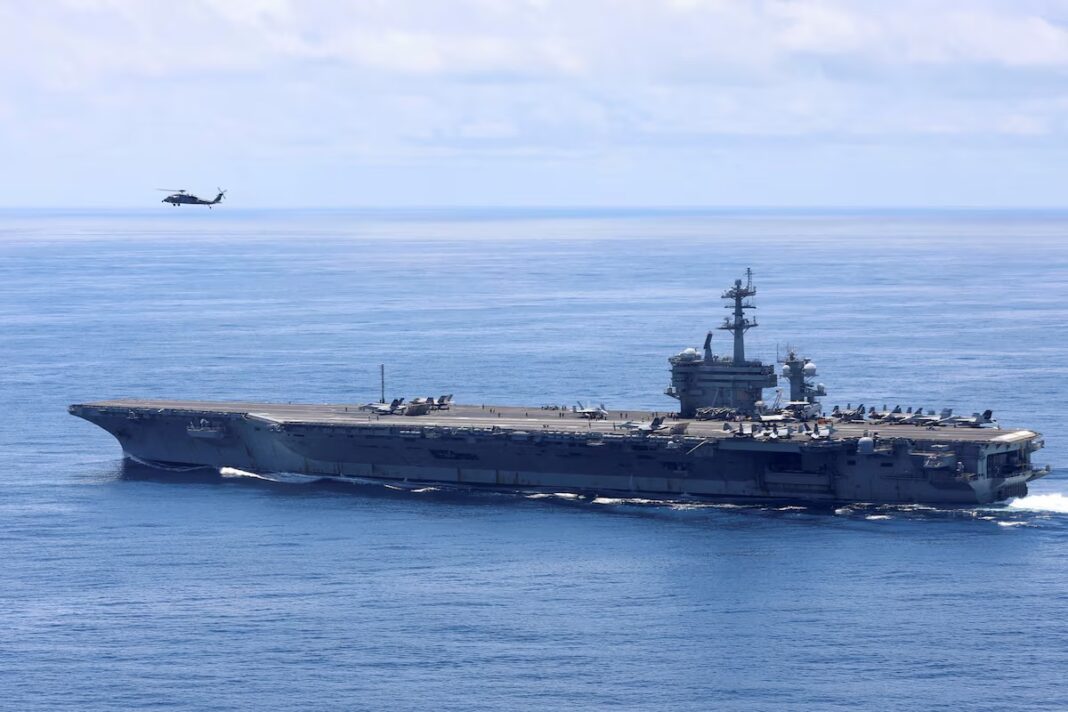South Korea, the United States, and Japan have launched a three-day joint military exercise called “Freedom Edge” starting Wednesday. The drills come in response to recent threats from North Korea. Including a recent intercontinental ballistic missile test. The test has raised security concerns across the region. The three countries have chosen to demonstrate their defense readiness and commitment to regional stability. The reports indicate that North Korean troops have begun supporting Russia in the conflict in Ukraine, which has added urgency to these exercises.
U.S. Aircraft Carrier Joins the Drills
The U.S. aircraft carrier, USS George Washington, has joined the training exercises. Along with fighter jets and maritime patrol aircraft from South Korea and Japan. The USS George Washington is a nuclear-powered aircraft carrier that brings significant capabilities to the exercise. This carrier’s involvement reflects the level of commitment the United States has towards supporting its allies in the Indo-Pacific region, particularly in the face of growing regional challenges.
Key Elements of the “Freedom Edge” Exercise
The exercises focus on several critical defense areas. South Korean and Japanese fighter jets are taking part in air-based drills, while maritime patrol aircraft are involved in monitoring and reconnaissance missions. The joint training will also include maritime missile defense training, which will help the nations improve their abilities to detect, intercept, and defend against missile threats. The cyber defense training is scheduled, allowing the forces to practice defending against potential digital attacks that could compromise national security.
Regional Security and Strategic Alliances
The “Freedom Edge” exercise is part of an ongoing commitment between South Korea, the United States, and Japan to hold annual drills aimed at strengthening their defense capabilities. The three countries reaffirmed this initiative during a 2023 summit. These joint exercises aim to strengthen security in East Asia. North Korea’s aggressive missile tests and militarization have raised serious concerns. North Korea has criticised these joint drills, viewing them as preparations for potential invasion. South Korea and its allies insist that the exercises are strictly defensive and intended to promote peace and stability.
Modernisation and Military Updates
The U.S. Air Force also recently announced plans to retire its A-10 Thunderbolt II aircraft from key areas, including South Korea, in 2025. The A-10 Thunderbolt II is a specialized aircraft designed to support ground troops. This change is part of a larger modernization strategy by the U.S. Air Force aimed at transitioning to more advanced and versatile equipment. Although the A-10s are known for their effectiveness in combat, the decision aligns with the U.S. Air Force’s commitment to adapting its assets to meet modern threats.
Increasing Cybersecurity Preparedness
Cybersecurity is an important focus in the “Freedom Edge” exercise, with cyber defense drills designed to enhance each nation’s ability to respond to cyber threats. In an era where digital attacks can disrupt infrastructure, data systems, and critical military operations, cybersecurity has become a primary concern. This aspect of the exercise shows that the nations are preparing not only for traditional warfare but also for the new-age threats posed by cyber warfare.
Challenges of Coordinated Defense
Coordination between South Korea, the U.S., and Japan in these drills emphasizes the necessity for effective communication and interoperability in multi-nation defense operations. Each country’s military forces bring unique strengths to the exercises. For instance, South Korea’s forces are familiar with North Korea’s tactics, the U.S. has vast technological resources, and Japan has advanced naval and air capabilities. By working together, the three countries hope to refine their collective ability to handle potential threats.
Significance for the Future of Security in Asia
The “Freedom Edge” exercise is another indication of how security dynamics in Asia are evolving. As countries in the region face increased threats from North Korea and deal with shifting global alliances. Exercises like these are likely to become more frequent and complex. China’s expanding influence in the region and Russia’s new alliance with North Korea compel South Korea, Japan, and the US to stay prepared. This trilateral partnership clearly signals to North Korea and other potential aggressors that they will protect regional security.
Looking Ahead
“Freedom Edge” marks another chapter in the ongoing commitment between South Korea, the US and Japan to protect their mutual interests. These drills are not merely exercises but also serve as a message to both North Korea and the broader international community. By conducting such high-level training together, these countries demonstrate that they are serious about ensuring the peace and stability of the region.
“Freedom Edge” exercise highlights the continued dedication of South Korea, the US, and Japan to security in East Asia. North Korea continues to push boundaries with missile tests and military actions. These joint drills are essential in maintaining a balance of power and deterring future conflicts.

